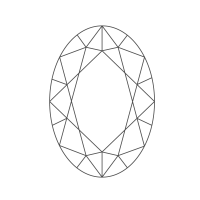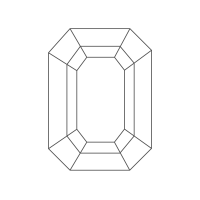Lab Diamond Cuts: Shapes and Considerations for Quality

Lab grown diamonds share the same chemical composition, optical properties, and physical features as natural diamonds, so they're an amazing alternative with several benefits (affordability, ethically sourced, environmental friendly). When you're shopping for lab diamonds, many factors contribute to how a diamond glitters, and cut is one of the most important ones. Continue reading to learn about shape options and all the components that impact the cut.
TABLE OF CONTENTS
What Are Lab Diamonds?
Lab grown diamonds provide consumers with a “real” diamond that look like earth-mined diamonds, and are also made of carbon like natural diamonds.
The process to create a lab grown diamond is similar to the process to create natural diamonds - the only difference is one occurs within the earth's crust and the other occurs in a laboratory. To create a lab grown diamond, the manufacturing process replicates conditions that create a natural diamond creation - extreme temperatures and pressures that turn carbon into a diamond.
Lab grown diamonds are evaluated using the same color, cut, carat and clarity scales and are IGI certified. Cut impacts the sparkle of the diamond and its overall appearance, so it's important to understand all that you can about the cut.
IGI grades diamonds on a scale of Ideal through Very Good. There are various factors that go into determining the cut grade of a diamond. Cut can be considered the most important “C” as it has a direct impact on sparkle and light refraction. Each diamond shape is graded on a variety of parameters to determine which cut grade it receives. As an example you can see the cut grade parameters for round diamonds in the chart below:
| Cut | Ideal | Excellent | Very Good |
|---|---|---|---|
| Table Width % | 53 - 60 | 52.5 - 63.5 | 51.4 - 63.5 |
| Crown Height % | |||
| Crown Angle % | 33 - 36 | 32.7 - 36.3 | 31.7 - 36.8 |
| Pavillion Depth % | 42 - 44 | 41.8 - 44.3 | 41.5 - 44.8 |
| Pavillion Angle | |||
| Girdle Thickness | Thin to Sl. Thick | Thin to Sl. Thick | Thin to Very Thick |
| Total Depth % | 58.5 - 62.5 | 56 - 63 | 53.5 - 63 |
| Culet Size % |
Lab Diamond Shapes
Shape options include cushion, emerald, marquis, oval, pear, princess, and round.

Cushion
This shape is also referred to as a pillow cut because of the softness of the shape's edges. The cushion shape has gently rounded corners and maximizes the gem's brilliance. They have trimmed corners for increased stability and are less prone to chipping. The popularity of cushion-shaped gemstones has increased in recent years.
Learn more about Cushion Cut Diamonds

Emerald
An emerald cut is made to emphasize long parallel step cuts along with clipped corners. The clipped corners prevent fractures and increase its stability. The parallel lines enhance the diamond's strength and durability to protect against chips. Although most emerald cuts are rectangular; square variations exist (called square emerald cuts). The emerald cut emphasizes the gemstone's color.
Learn more about Emerald Cut Diamonds

Marquise
Marquise cuts are longer than they are wide - an elongated gemstone that is pointed at both ends. The stone needs perfect symmetry to ensure the stone sits properly in the setting to minimize chipping or breakage at the two points.
Learn more about Marquise Cut Diamonds

Oval
This variation of the round gemstone shape offers the brilliance and fire of round cut gemstones but in a more unique shape. This shape also helps to create the illusion of a larger gemstone. Oval gemstones have increased in popularity in the past couple years, and some say they're one of the most popular shapes. Its round shape and lack of points makes this a durable choice.
Learn more about Oval Cut Diamonds

Pear
Also known as a teardrop-shaped cut, pear-shaped gemstones include a point on one end and a rounded edge on the other. Pear-shaped gemstones have become more popular recently. Its unique shape adds character to jewelry and makes a statement. Stones are most delicate at their points, so you'll want to make sure the point of the pear isn't too pointy to prevent breaking.
Learn more about Pear Cut Diamonds

Princess
Generally, a rectangle-shaped princess cut is the second most popular cut behind the round brilliant. A variety of facets are acceptable for princess cut gemstones, but will also have sparkle. The square attributes of a princess cut also mean the gem retains more of the rough stone in the cutting process. To ensure your princess cut gemstone is durable, make sure the points are protected by prongs.
Learn more about Princess Cut Diamonds

Round
Can you believe that round gemstones have 58 facets? Hard to believe, but it explains how light makes them sparkle. Round gemstones, especially round diamonds, are a popular gemstone shape. It's a popular choice for diamonds because it showcases the stone's brilliance and fire. Round gemstones are very durable because they don't have corners or points.
Learn more about Round Cut Diamonds

Asscher
Asscher cuts look similar to emerald cuts, but they are square shaped rather than rectangular.
Learn more about Asscher Cut Diamonds

Radiant
The radiant cut diamond combines the brilliance of a round cut with an emerald cut. It's a beautifully symmetrical, non-traditional cut that offers more sparkle than a typical emerald cut.
Learn more about Radiant Cut Diamonds
Parts of the Diamond
Diamonds have components that impact the stone's brilliance and sparkle in terms of reflection, refraction, and dispersion. Before we dive into the anatomy of a diamond, let's explain the terms behind the sparkle:
- Reflection: This is the light that hits the diamond and is immediately bounced back up, giving instantaneous shine.
- Refraction: This refers to the diamonds' fire. As light enters the diamond, it's bent and scattered to create its sparkle and brilliance. Diamonds have a high index of refraction (about 2.4).
- Dispersion: This refers to the rainbow effect when white light enters the top of the diamond, is angled around the inside of the diamond and aimed back towards the top and out through the surface. This adds to the shine.

Now that you understand the terms used to describe a diamond's brilliance, let's examine a few terms that impact a diamond's complex cut:
- Culet: Bottom tip of the diamond.
- Pavilion: Bottom half of the diamond.
- Girdle: The part of a diamond that separates the crown (top) from the pavilion (bottom).
- Crown: The upper section that is typically the most visible part of the gemstone because it faces upwards towards the wearer.
- Depth: Diamond depth is a crucial factor of a diamond's cut. The depth of a diamond is its height (in millimeters) measured from the culet (bottom tip) to the table (flat, top surface).
- Table: A diamond's table refers to the flat facet of the diamond which can be seen when the stone is face up. As the largest facet on a diamond, a diamond's table plays a vital role in creating the diamond's brilliance by refracting entering light rays and allowing reflected light rays back into the observer's eye.
Every diamond is unique, so take a close look at the cut of any diamond you're considering. Selecting a lab diamond allows you to make the most of your budget - you can get a high quality, large stone for an affordable price.
FAQs
Are lab-grown diamonds real?
Are lab diamonds better in terms of quality?
Which is the best cut for a lab diamond?
For which shapes is it important to get a higher cut grade?









